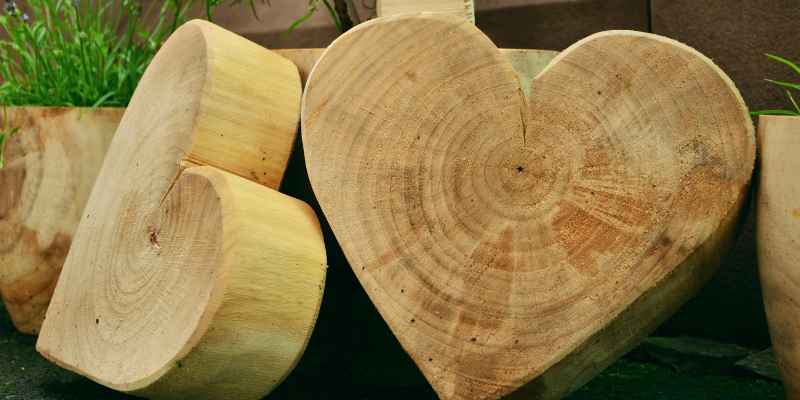Purple Heart wood is primarily found in Central and South America, specifically in countries such as Brazil, Costa Rica, Panama, and Colombia. It is a hardwood known for its distinctive deep purple color.
What Is Purple Heart Wood
What is Purple Heart Wood: Purple Heart wood is a type of hardwood known for its distinct deep purple color. It is derived from the Peltogyne tree, primarily found in Central and South America.
Characteristics Of Purple Heart Wood
- Distinctive Deep Purple Color: Purple Heart wood is recognized for its vibrant purple hue, which sets it apart from other types of wood.
Distinctive Deep Purple Color
Purple Heart wood stands out due to its striking deep purple color, making it a popular choice for woodworking projects.

Origin Of Purple Heart Wood
Purple heart wood is a type of hardwood that is prized for its distinctive and striking deep purple color. The scientific name of the tree that produces purple heart wood is Peltogyne, and it is found primarily in Central and South America.
Central And South America As The Primary Regions
Purple heart wood is primarily found in Central and South America. The dense forests of this region are home to the Peltogyne tree, which produces the renowned purple heart wood.
Specific Countries Where It Grows
- Brazil
- Colombia
- Costa Rica
- Panama
Abundance In The Amazon Basin
Purple heart wood is abundant in the Amazon Basin, making it a significant source of this prized hardwood. The lush and diverse ecosystem of the Amazon Basin provides the ideal conditions for the growth of the Peltogyne tree, contributing to the widespread availability of purple heart wood in the region.
Where Does Purple Heart Wood Grow In The Us
Limited Growth In The Us
Purple Heart Wood, known for its deep purple color, primarily grows in Central and South America, with limited growth in the US. Due to its unique color and durability, it is highly sought after for woodworking projects, but its growth is restricted to specific regions within the US.
Potential Locations In The Us
- Austin, Texas: Known for its diverse flora, Austin, Texas, has been identified as a potential location for the growth of Purple Heart Wood. Its favorable climate and suitable soil conditions make it conducive for the growth and cultivation of this prized hardwood.
- Costa Rica and Panama: While not within the US, the Pacific coast of Costa Rica and Panama and the Atlantic coast of Colombia have been recognized as areas where the Peltogyne tree, which produces Purple Heart Wood, is native. These regions share similar environmental factors to certain areas within the US, suggesting the potential for growth in comparable locations.
How Does Purple Heart Wood Change Color
Purple Heart wood, known for its striking deep purple color, comes from the Peltogyne tree primarily found in Central and South America, ranging from Southeastern Brazil to Costa Rica and Trinidad, with most species growing in the Amazon basin. The bright purple color of the wood will fade to a darker brownish plum over time if not finished with a UV protectant and exposed to direct sunlight.

Natural Color Transformation
Purple Heart wood is known for its vibrant deep purple hue.
However, over time, this color undergoes a remarkable transformation.
The natural color evolution of Purple Heart wood is unique and fascinating.
Factors Influencing Color Change
- Sunlight Exposure: Direct sunlight can cause Purple Heart wood to darken.
- Oxidation: The wood reacts with oxygen, altering its color.
- Finishing: UV protectants can help preserve the original purple shade.
Preserving The Purple Color
To maintain the purple hue of Purple Heart wood,
it is essential to seal and finish the wood properly.
Protecting it from excessive sunlight exposure is crucial.
Proper care will ensure the wood retains its striking color.
Advantages And Uses Of Purple Heart Wood
Purple Heart wood comes from Peltogyne trees found in Central and South America, including regions from Mexico through Southern Brazil and the Amazon Basin. This distinctive hardwood is prized for its striking deep purple color and is used in flooring, woodworking, and other decorative applications.
Its color, however, may fade to a darker brownish plum, which can be prolonged by finishing with UV protectant and avoiding direct sunlight exposure.
Purple Heart wood is a highly sought-after hardwood known for its distinctive and striking deep purple color. But its benefits extend beyond its aesthetics. Let’s explore some of the advantages and uses of Purple Heart wood that make it a valuable material in woodworking, furniture, and decor.
Exceptional Grain Pattern
The grain pattern of Purple Heart wood is exceptional and adds a unique touch to any project. With its fine to medium texture and straight to irregular grain, Purple Heart wood offers a beautiful and distinct look that sets it apart from other hardwoods. Its linear grain pattern adds depth and visual interest to furniture and decor pieces, making them stand out in any setting.
Unique Qualities In Woodworking
When it comes to woodworking, Purple Heart wood boasts unique qualities that make it a favorite among craftsmen. Its density is one of its standout features, providing durability and strength to the finished product. This hardwood is also highly resistant to decay and insects, making it a reliable choice for outdoor furniture and structures.
Working with Purple Heart wood can be a delight due to its good machinability. It can be easily carved, cut, and shaped, allowing craftsmen to create intricate details and designs. Whether it’s a delicate trim or a complex decorative element, Purple Heart wood offers versatility and ease in the woodworking process.
Applications In Furniture And Decor
Purple Heart wood finds extensive use in furniture and decor due to its rich color and exceptional properties. Its vibrant purple hue adds a touch of luxury and sophistication to any interior. From statement pieces like tables and cabinets to smaller accents like bowls and trays, Purple Heart wood infuses a distinct character into every creation.
In addition to its visual appeal, Purple Heart wood also has excellent dimensional stability, meaning it is less prone to warping or shrinking over time. This makes it a reliable choice for furniture that needs to withstand changes in humidity or temperature.
Furthermore, Purple Heart wood takes finishes exceptionally well, allowing craftsmen to showcase its natural beauty while protecting it from wear and tear. A simple application of a clear coat or wood stain can enhance the color and grain pattern, bringing out the full potential of this remarkable wood.
In conclusion, Purple Heart wood’s exceptional grain pattern, unique qualities in woodworking, and applications in furniture and decor make it a highly desirable material for craftsmen and designers alike. Its distinct purple color adds a touch of elegance and individuality to any project, ensuring that the finished pieces stand out and leave a lasting impression.
Disadvantages And Safety Concerns
While purple heart wood is highly valued for its stunning purple color and durability, it does come with a few disadvantages and safety concerns that should be considered. In this section, we will explore the potential allergic reactions and sensitivities associated with purple heart wood, as well as the precautions one should take when working with this unique hardwood.
Allergic Reactions And Sensitivities
Purple heart wood has been known to cause allergic reactions and sensitivities in some individuals. Although severe reactions are rare, it is important to be aware of the potential risks. Common reactions may include eye and skin irritations, as well as nausea. It is recommended to take proper precautions when handling and working with purple heart wood to minimize the risk of these allergic reactions.
Precautions To Take
When working with purple heart wood, it is essential to follow certain precautions to ensure your safety and well-being. Here are a few measures you should consider:
- Wear protective goggles and gloves to protect your eyes and skin from potential irritations.
- Work in a well-ventilated area or use a respirator to avoid inhaling wood dust, especially if you are sensitive to airborne particles.
- Use tools with sharp blades to minimize tear-out and reduce the potential for skin irritations.
- Avoid prolonged direct contact with the wood, as this may increase the likelihood of skin reactions.
- After working with purple heart wood, thoroughly wash your hands and any exposed areas of skin to remove any potential irritants.
- If you experience any symptoms of an allergic reaction, such as itching, redness, or difficulty breathing, seek medical attention immediately.
By taking these precautions, you can minimize the risks associated with working with purple heart wood and enjoy its beauty and durability without compromising your safety.
Frequently Asked Questions Of Where Does Purple Heart Wood Grow
Where Does Purple Heart Wood Come From In The Us?
Purple Heart wood in the US is primarily sourced from the Peltogyne tree found in Central and South America.
Where Does Purple Heart Timber Grow?
Purple Heart wood mainly grows in Central and South America, stretching from Mexico to Southern Brazil. The tree responsible for this wood is known as Peltogyne.
Where Do You Find Purple Heart Trees?
Purple Heart trees are primarily found in Central and South America, ranging from Mexico to Southern Brazil. They are known for their distinctive bright purple coloring, although the color may fade to a darker brownish plum over time. To maintain the color, it is recommended to finish the wood with a UV protectant and avoid direct sunlight exposure.
What Are The Disadvantages Of Purple Heart Wood?
Purple Heart wood may cause skin and eye irritation and can sensitize some individuals. Protect it from direct sunlight to maintain color.
Conclusion
The purple heart wood, with its vibrant color, is mainly found in Central and South America. It is essential to protect its unique hue from fading with proper finishing and sunlight precautions. Discover the beauty and durability of purple heart wood in your woodworking projects.

